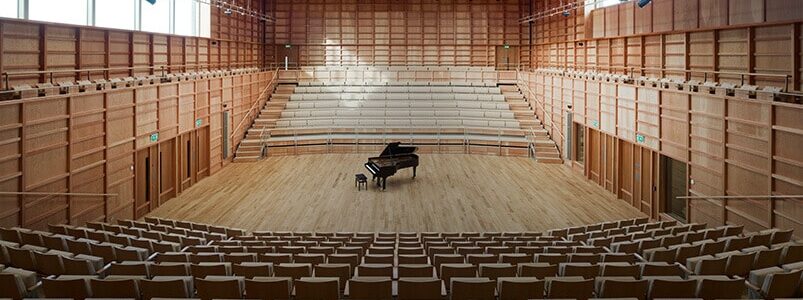Why acoustic doors are perfect for theatres and concert halls
It’s been a while since we looked at the role of acoustic doors in environments with very demanding acoustic specifications. One obvious example is recording studios, where if unwanted noise gets in and onto the recording, it will obviously cause problems. It’s perhaps not so much of a problem if noise gets out – imagine if you’d been outside Abbey Road Studios when Sgt. Pepper was being recorded … although the Beatles might not have been too happy!
But on a serious note, acoustic doors act as a sound barrier to noise getting in or out, so it works both ways. And they have a particularly important role to play in environments where noise needs to be controlled but where people are moving around all the time. An excellent example is a concert hall or theatre.
What are the characteristics of a concert hall or theatre?
For a start, unlike a recording studio, they tend to be large – with seating or standing room for hundreds and possibly thousands of people. Another significant difference is that the venue’s acoustic requirements will have a different emphasis – it’s not so critical for sound to be contained within the auditorium, but it is important that (as far as possible) sound doesn’t escape from and into the auditorium.
Then we have to consider the overall acoustics within the venue itself, and how to ensure that the performance sounds as good as it possibly can to everyone in the audience.
And when we think about the number of people constantly moving around, and the need for the doors to perform the required level of soundproofing as well as fulfilling safety requirements (e.g. fire protection), we see that it’s a real challenge.
If you’re interested in how to solve it – read on!
Designing a concert hall or theatre
- Unsurprisingly, the process begins with testing, using an acoustic model. There are two types – scale models and computer models. The level of detail required for an acoustic model is greater than that for an architectural model – for example the materials must be the same so that the tests accurately reflect what will happen to sound in the finished hall. As the model is smaller than the real hall, the frequency of the test sounds must be proportionately higher (e.g. in a 1:10 scale model the sound frequency must be 10 times higher than it would be in the real hall). There’s clearly a lot to it!
- The shape of the hall is critically important. Do we opt for the “shoe box” shape (long, tall, and narrow), which has beneficial side reflections, (such as the Royal Festival Hall)? Or the fan-shaped hall, with reduced side reflections, (like the Barbican)? Or perhaps the “Vineyard Terrace”, where the audience is subdivided thus providing more beneficial reflections from the dividing walls (a good example is the Berlin Philharmonie)?
- And what about the walls? Do we want them to reflect sound back into the auditorium, to absorb the sound, or to disperse it in different directions?
- Studies have shown that the volume of the sound reaching the listener is the single most important factor in determining their emotional response. One of the pre-eminent concert hall designers and acoustic engineers of the twentieth century, Leo Beranek, wrote: “The thrill of hearing Bach’s B minor Mass, Beethoven’s Ninth Symphony, or Mahler’s Eighth Symphony is not only determined by the quality of the orchestra and interpretation of the conductor, but is enhanced immeasurably by the dynamic response of the concert hall. Response means both quiet support for the pianissimo parts and majestic levels at the fortissimos”
- Earlier we mentioned the importance of ensuring that unwanted sound doesn’t enter the auditorium. Many concert halls are in busy city centres, with lots of traffic noise within a very short distance. Excellent sound insulation is therefore needed.
We told you it was a challenge!
So what’s to be done to meet the challenge?
Well, when it comes to the doors, as we’ve seen it very much depends on the particular characteristics of the hall or theatre in question. We look at the acoustic rating of the door to determine its performance, and we measure it using the Weighted Sound Reduction Index (Rw). Increasing the Rw by 1 translates to a reduction of approximately 1db in noise level. Therefore, the higher the Rw number, the better at controlling noise it will be.
How to get expert advice
It’s important that you talk to experts who specialise in the manufacture and installation of acoustic doors – and who can give you excellent advice and guidance based on years of successful installations and a large and satisfied customer base.
If you would like further information on our company please visit our home page or go directly to our contact page when we will respond as quickly as possible.
As always we’ll be delighted to help and advise you.









